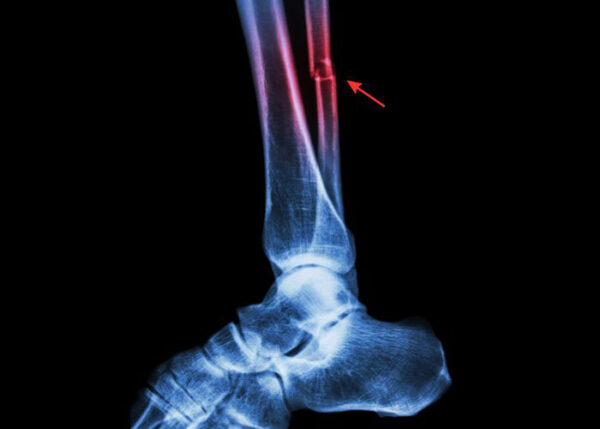Fibula Fracture Specialists
Are you involved in aggressive contact sports such as soccer, rugby, and football? If so, you have the highest likelihood of experiencing a fibula fracture. Fibula fractures can cause pain, bruising and difficulty walking. It is important to have a fibular fracture treated correctly to maintain the structural integrity of the foot and ankle. Foot and ankle specialists, Doctors Thomas Haytmanek and Jonathon Backus have diagnosed and treated many patients in Vail and Frisco, Colorado, as well as Denver, Boulder, and surrounding Summit County areas who have experienced a fibula fracture. Contact The Steadman Clinic’s Sports Foot and Ankle team today!

What is a fibula fracture?
The fibula is one of the three bones that form the ankle joint. This slender and elongated bone tracks along the lateral lower leg next to the tibia (shin bone). While it has a minor role in weight-bearing, the fibula provides insertion sites for multiple lower leg muscles to aid in transferring ground forces when walking. The fibula can break at the ankle and knee joints as well as the shaft (middle portion). Individuals involved in aggressive contact sports such as soccer, rugby, and football have the highest likelihood of experiencing a fibula fracture. The fibula is also heavily impacted in other sports like skiing and snowboarding; these athletes are also prone to experiencing a fibula fracture. Dr. Thomas Haytmanek and Dr. Jonathan Backus specialize in treating fibula fractures for patients from Vail and Frisco, Colorado, as well as Denver, Boulder, and surrounding Summit County areas.

Are there different types of fibula fractures?
Yes. There are five categories of fibula fractures, as follows:
- Fibular Shaft. The break is found along the fibula’s slender and elongated middle portion.
- Lateral Malleolus. The lowest portion closest to the ankle of the fibula is involved in this type of fracture.
- Fibular Head. The fracture is located where the fibula meets the knee joint.
- Stress Fracture. Repetitive injury to the fibula can create hairline fractures at any location of the fibula.
- Avulsion Fracture. A sudden muscle contraction can pull a portion of the fibula away from its attachment site.
What are the symptoms of a fibula fracture?
Fibula fractures often occur as part of a larger injury involving other bones and soft tissues associated with the ankle and/or knee joints. Therefore, individuals may not be aware of fibular involvement until assessed by an orthopedic foot and ankle specialist. Some common symptoms of a fibula fracture include:
- Bruising and inflammation of the lower leg
- Pain that worsens with weight-bearing or added pressure
- Numbness and/or tingling signifying nerve injury or significant swelling.
How is a fibula fracture diagnosed?
While the patient’s medical history and physical examination are important, x-ray imaging is the best diagnostic tool to confirm a fibula fracture. If a stress fracture is suspected due to the patient’s activity level and symptoms, Dr. Haytmanek and Dr. Backus may request advanced imaging to evaluate the surrounding soft tissue structures.
What is the treatment for a fibula fracture?
Non-surgical treatment:
Patients with non-displaced fibula fractures or those with a stable syndesmosis and deltoid ligament injury often benefit from conservative therapies. Live stress radiographs may be necessary to prove that the fracture is stable. A short period of non-weight bearing in a walking boot or short leg cast helps to prevent further displacement of the bone fragments. X-rays are important during this period of immobilization to ensure the fracture is fusing appropriately. Rest, ice, elevation, and non-steroidal anti-inflammatory medications (NSAIDs) can help relieve any pain and swelling associated with a fibula fracture. A physical therapy program focused on ankle strengthening may be appropriate depending on the patient’s specific needs.
Surgical treatment:
Fibula fractures with displacement and ligamentous instability typically require more invasive treatment. Patients who try and fail conservative measures are also candidates for surgical intervention. Fibula fractures are most often surgically realigned through a procedure known as open reduction and internal fixation (ORIF). Special plates and screws are utilized to correctly align the bony fragments.
